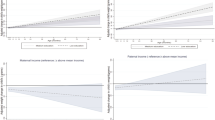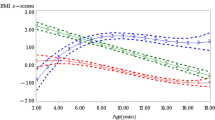Abstract
Background/objectives:
In economically developed settings, household income is usually inversely associated with child and adolescent adiposity, but this association may not extend to migrants. Hong Kong is a unique developed setting to study how household income and adolescent adiposity vary by migrant status given many Hong Kong-born Chinese children were born to parents who migrated from neighboring provinces of Mainland China.
Subjects/methods:
We examined differences between the associations of absolute household income vs. relative household income on adolescent body mass index (BMI) z-score or overweight (including obesity) status using a linear or logistic model in a Chinese birth cohort (n = 5613, 68% follow-up). We focused on whether the associations differed by mother’s or father’s migrant status (birthplace).
Results:
No association was found between absolute household income and BMI z-score among adolescents with either native or migrant mothers. However, the association of relative household income with BMI z-score varied by mother’s migrant status (P-values for interaction <0.0005). In adolescents of native born mothers, greater relative household income deprivation was associated with higher BMI z-score (0.03 z-score per USD 128 difference in Yitzhaki index, 95% confidence interval (CI) 0.01 to 0.05). However, in adolescents of migrant mothers, greater relative household income deprivation was associated with lower BMI z-score (−0.05, 95% CI −0.09 to −0.01). Similar association of relative household income with overweight (including obesity) status was found in adolescents of native born mothers but not in adolescents of migrant mothers.
Conclusions:
Relative income (mediated by social comparisons with others in society) appears to be relevant to adolescent adiposity, but the association depends on the interplay between individual characteristics (migrant background) and societal context.
This is a preview of subscription content, access via your institution
Access options
Subscribe to this journal
Receive 12 print issues and online access
$259.00 per year
only $21.58 per issue
Buy this article
- Purchase on Springer Link
- Instant access to full article PDF
Prices may be subject to local taxes which are calculated during checkout
Similar content being viewed by others
References
Department of Health Public Health Research Consortium, Law C, Power C, Graham H, Merrick D. Obesity and health inequalities. Obes Rev. 2007;8:19–22. Suppl 1
Sobal J, Stunkard AJ. Socioeconomic status and obesity: a review of the literature. Psychol Bull. 1989;105:260–75.
Dinsa GD, Goryakin Y, Fumagalli E, Suhrcke M. Obesity and socioeconomic status in developing countries: a systematic review. Obes Rev. 2012;13:1067–79.
Wang Y. Cross-national comparison of childhood obesity: the epidemic and the relationship between obesity and socioeconomic status. Int J Epidemiol. 2001;30:1129–36.
Due P, Damsgaard MT, Rasmussen M, Holstein BE, Wardle J, Merlo J, et al. Socioeconomic position, macroeconomic environment and overweight among adolescents in 35 countries. Int J Obes. 2009;33:1084–93.
Shrewsbury V, Wardle J. Socioeconomic status and adiposity in childhood: a systematic review of cross-sectional studies 1990-2005. Obesity. 2008;16:275–84.
Wang Y, Zhang Q. Are American children and adolescents of low socioeconomic status at increased risk of obesity? Changes in the association between overweight and family income between 1971 and 2002. Am J Clin Nutr. 2006;84:707–16.
Van Hook J, Balistreri KS. Immigrant generation, socioeconomic status, and economic development of countries of origin: a longitudinal study of body mass index among children. Soc Sci Med. 2007;65:976–89.
Harling G, Subramanian SV, Barnighausen T, Kawachi I. Income inequality and sexually transmitted in the United States: who bears the burden? Soc Sci Med. 2014;102:174–82.
Putnam JJ, Allshouse JE. Food expenditures and income. In: Food consumption, prices, and expenditures, 1970-97. Washington, DC: Economic Research Service, United States Department of Agriculture (USDA); 1999.
Drewnowski A. Obesity, diets, and social inequalities. Nutr Rev. 2009;67:S36–9. Suppl 1
Li X, Gauthier AH, Strohschein L. Why are some children left out? Factors barring Canadian children from participating in extracurricular activities. Can Stud Popul. 2009;36:325–45.
Perry CD, Kenney GM. Preventive care for children in low-income families: how well do Medicaid and state children’s health insurance programs do? Pediatrics. 2007;120:e1393–401.
Runciman WG. Relative deprivation and social justice: a study of attitudes to social inequality in twentieth-century. England: University of California Press; 1966.
Wood AM, Boyce CJ, Moore SC, Brown GD. An evolutionary based social rank explanation of why low income predicts mental distress: a 17 year cohort study of 30,000 people. J Affect Disord. 2012;136:882–8.
Hamer M, Steptoe A. Cortisol responses to mental stress and incident hypertension in healthy men and women. J Clin Endocrinol Metab. 2012;97:E29–34.
Gundersen C, Mahatmya D, Garasky S, Lohman B. Linking psychosocial stressors and childhood obesity. Obes Rev. 2011;12:e54–63.
Kawachi I,Adler NE,Dow WH, Money, schooling, and health: mechanisms and causal evidence. Ann. Y Acad Sci. 2010;1186:56–68.
Tsang S. A modern history of Hong Kong. London; New York: I.B. Tauris; 2003.
Schooling CM, Hui LL, Ho LM, Lam TH, Leung GM. Cohort profile: ‘Children of 1997’: a Hong Kong Chinese birth cohort. Int J Epidemiol. 2012;41:611–20.
Organization for Economic Co-operation and Development (OECD) Project on Income Distribution and Poverty. Income Distribution Database (IDD): Gini, poverty, income, methods and concepts—what are equivalence scales? 2012 [15 Jan 2018]. Available from: http://www.oecd.org/social/income-distribution-database.htm [Under methods and concepts section] or http://www.oecd.org/els/soc/OECD-Note-EquivalenceScales.pdf.
Kwok MK, Subramanian SV, Leung GM, Schooling CM. Household income and adolescent blood pressure in a Chinese birth cohort: “Children of 1997”. Soc Sci Med. 2015;144:88–95.
Yitzhaki S. Relative deprivation and the Gini coefficient. Quaterly J Econ. 1979;93:321–4.
Brown GDA, Gardner J, Oswald AJ, Qian J. Does wage rank affect employees’ wellbeing? IZA Discussion paper series, No.1505 2005.
World Health Organization (WHO). WHO growth reference 5-19 years. Geneva: WHO; 2007.
Cole TJ, Bellizzi MC, Flegal KM, Dietz WH. Establishing a standard definition for child overweight and obesity worldwide: international survey. BMJ. 2000;320:1240–3.
Sun X, Briel M, Walter SD, Guyatt GH. Is a subgroup effect believable? Updating criteria to evaluate the credibility of subgroup analyses. BMJ. 2010;340:850–4.
Seaman SR, White IR, Copas AJ, Li L. Combining multiple imputation and inverse-probability weighting. Biometrics. 2012;68:129–37.
Schafer JL. Multiple imputation: a primer. Stat Methods Med Res. 1999;8:3–15.
Moons KG, Donders RA, Stijnen T, Harrell FE Jr. Using the outcome for imputation of missing predictor values was preferred. J Clin Epidemiol. 2006;59:1092–101.
Powell LM, Wada R, Krauss RC, Wang Y. Ethnic disparities in adolescent body mass index in the United States: the role of parental socioeconomic status and economic contextual factors. Soc Sci Med. 2012;75:469–76.
Oliver LN, Hayes MV. Effects of neighbourhood income on reported body mass index: an eight year longitudinal study of Canadian children. BMC Public Health. 2008;8:16.
Rossen LM. Neighbourhood economic deprivation explains racial/ethnic disparities in overweight and obesity among children and adolescents in the U.S.A. J Epidemiol Community Health. 2014;68:123–9.
Currie C, Molcho M, Boyce W, Holstein B, Torsheim T, Richter M. Researching health inequalities in adolescents: the development of the Health Behaviour in School-Aged Children (HBSC) family affluence scale. Soc Sci Med. 2008;66:1429–36.
Lam KC, Liu PW. Earnings divergence of Immigrants. J. Labor Econ. 2002;20:86–104.
Cheung NW. Social stress, locality of social ties and mental well-being: the case of rural migrant adolescents in urban China. Health Place. 2014;27:142–54.
Leung CY, Leung GM, Schooling CM. Migrant status and child and adolescent psychological well-being: evidence from Hong Kong’s ‘Children of 1997’ birth cohort. J Epidemiol Community Health. 2015;69:156–61.
Lam KC, Liu PW. Intergenerational educational mobility in Hong Kong: are immigrants more mobile than natives?: Institute of Global Economics and Finance of The Chinese University of Hong Kong; 2015 [31 May 2017]. Available from: http://www.igef.cuhk.edu.hk/igef_media/working-paper/IGEF/igef_working_paper_no_42_eng.pdf.
Albrecht SS, Gordon-Larsen P. Socioeconomic gradients in body mass index (BMI) in US immigrants during the transition to adulthood: examining the roles of parental education and intergenerational educational mobility. J Epidemiol Community Health. 2014;68:842–8.
Beydoun MA, Wang Y. Parent-child dietary intake resemblance in the United States: evidence from a large representative survey. Soc Sci Med. 2009;68:2137–44.
Lee S. Fat, fatigue and the feminine: the changing cultural experience of women in Hong Kong. Cult Med Psychiatry. 1999;23:51–73.
Woo J, Leung SS, Ho SC, Sham A, Lam TH, Janus ED. Influence of educational level and marital status on dietary intake, obesity and other cardiovascular risk factors in a Hong Kong Chinese population. Eur J Clin Nutr. 1999;53:461–7.
Jones-Smith JC, Gordon-Larsen P, Siddiqi A, Popkin BM. Emerging disparities in overweight by educational attainment in Chinese adults (1989-2006). Int J Obes. 2012;36:866–75.
Lam KC, Liu PW. Relative returns to skills and assimilation of immigrants in Hong Kong. Pac Econ Rev. 2002;7:229–43.
Egerter S, Braveman P, Sadegh-Nobari T, Grossman-Kahn R, Dekker M. Exploring the social determinants of health: education and health. United States: Robert Wood Johnson Foundation Comission to Build a Healthier America; 2011.
Zhang X. The effects of parental education and family income on mother-child relationships, father-child relationships, and family environments in the People’s Republic of China. Fam Process. 2012;51:483–97.
Willgerodt MA. Family and peer influences on adjustment among Chinese, Filipino, and White youth. Nurs Res. 2008;57:395–405.
Schooling CM, Yau C, Cowling BJ, Lam TH, Leung GM. Socio-economic disparities of childhood body mass index in. newly developed population: evidence from Hong Kong’s ‘Children of 1997’ birth cohort. Arch Dis Child. 2010;95:437–43.
Acknowledgements
The authors thank colleagues at the Student Health Service and Family Health Service of the Department of Health for their assistance and collaboration. They thank Dr. Connie Hui for her assistance with the record linkage and the late Dr. Connie. for coordinating the project and all the fieldwork for the initial study in 1997–1998. M.K.K. thanks the Takemi Program in International Health at the Harvard T.H. Chan School of Public Health for her fellowship during which this manuscript was prepared.
Funding:
This work is a sub-study of the “Children of 1997” birth cohort which was initially supported by the Health Care and Promotion Fund, Health and Welfare Bureau, Government of the Hong Kong SAR [HCPF Grant #216106] and re-established in 2005 funded by the Health and Health Services Research Fund [HHSRF Grant #03040771]. This sub-study was funded by the Research Fund for the Control of Infectious Diseases [RFCID Grant #04050172] and the Health and Health Services Research Fund [HHSRF Grants #07080751 and #08090761], Government of the Hong Kong SAR.
Author information
Authors and Affiliations
Corresponding author
Ethics declarations
Conflict of Interest
The authors declare that they have no conflict of interest.
Electronic supplementary material
Rights and permissions
About this article
Cite this article
Kwok, M.K., Schooling, C.M., Subramanian, S.V. et al. Opposite associations of household income with adolescent body mass index according to migrant status: Hong Kong’s “Children of 1997” birth cohort. Int J Obes 42, 1221–1229 (2018). https://doi.org/10.1038/s41366-018-0118-x
Received:
Revised:
Accepted:
Published:
Issue Date:
DOI: https://doi.org/10.1038/s41366-018-0118-x



